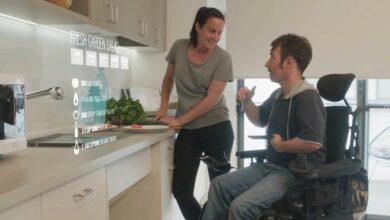Keeping staff safe
Industry leaders are calling on governments to act on workplace injuries, verbal abuse and violence. Cathy Wever reports
With issues to contend with such as injuries from manual handing, aggression and even violence from patients and their families, the workplace for nurses poses some significant health and safety challenges.
Against such a backdrop, many employers, legislators and policy makers are working hard to make it safer to work as a nurse, yet theirs is no easy task.
Aggression on the rise
Danny Hills from Monash University has spent many years looking at aggression in nursing and medicine.
He says incidences of aggression towards nurses have been trending upwards in the past 15 years, not just in the emergency and mental health departments, but also on surgical and general wards.
"There is research to suggest that aggression is on the rise, however we also know more about aggression, so it's more likely to be recognised, named and reported," says Hills.
Indeed, the International Council of Nurses advocates "sensitising the public and the nursing community to the various manifestations of violence against nursing personnel" and Hills says campaigns in various states that promote a zero tolerance approach towards aggression and violence have proven effective in heightening awareness of the problem while the same time increasing the reporting of incidents.
"Aggression traverses all sectors. Because it's inherent in healthcare work, people often play it down. This is especially true of verbal aggression, however this has been shown to have just as dramatic consequences as physical aggression.
"It can impact health and wellbeing, increase absenteeism and contribute to decisions around ongoing workforce participation - both long and short term."
Hills says aggression in the workplace is not adequately addressed through current legislation, citing a 2010 study into the attention given to psychosocial hazards (such as workplace aggression) by Australian OHS inspectors which revealed these to be "a marginal area of inspectorate activity".
"It's a low priority at the government level. Politicians say it's not but when you look at the legislation there's nothing in there that really addresses workplace aggression properly. It's a massive issue in the health system - you have people who are sick and distressed, and then you have nurses who are under pressure all the time.
"Everybody is asked to work better with less - it's a reality everywhere - but just because something's inherent in the work doesn't mean it's right. Enough is known about aggression in nursing for more of a concerted effort to occur to reduce it."
Through his own research, Hills has examined ways of minimising aggression and violence towards nurses.
"Nurse training is certainly important and yes, you can provide education to deal with these issues, but the training does take a long time. Good communication and de-escalation skills that can diffuse potentially aggressive situations take a long time to develop."
As a result, Hills says young clinicians are at the highest risk of experiencing the negative consequences of aggression in the workplace.
"Another key factor in the prevention research relates to environment design. Safety mechanisms, the design of the hospital or care facility... there's a lot more work that needs to be done to find out what works best."
Australian Nursing Federation (Vic) OHS co-ordinator Kathy Chrisfield also says workplace design can lessen nurses' exposure to workplace aggression, as well as other safety risks.
"The physical environment - the design of the workplace, the layout and also the staffing levels, can contribute to overall safety levels," Chrisfield says.
She points to a 2010 La Trobe University survey of 1500 nurses and midwives that revealed more than one third had experienced some kind of occupational violence including verbal abuse, threat of harm and physical abuse such as punching, striking, pushing, scratching and grabbing.
In terms of where the ANF's OHS unit is spending its time, Chrisfield says occupational violence and exposure to aggressive patients and families is top of the list. The situation is similar in NSW, where worker's compensation claims involving physical assaults in public hospitals have jumped considerably in the past three years despite a zero tolerance policy towards violence.
In Victoria, the ANF has asked the state government to provide ongoing funding to hospitals to employ security guards for emergency departments and increase staffing levels in EDs as a way of curtailing the frustration of long waiting periods that often contributes to an escalation of violence and aggression towards nurses.
Workplace injuries
Patient handling, lack of equipment and injuries that occur from this are also key workplace issues regularly dealt with by the ANF's OHS department.
"The no lifting policy was introduced 12 years ago and it has made a huge difference in terms of back injuries, but there are still some settings where nurses don't have access to the equipment needed to properly assist with lifting, or where there aren't the numbers of staff required to use the lifting machines. We also still see facilities being designed so that lifting machines don't easily fit through ensuite doors or there are not tracking systems in place. There are certainly ways to make working environments safer for nurses and they should be factored in from day one."
Chrisfield says the increasing number of bariatric patients is creating an additional workplace safety issue for nurses, particularly for those in aged care.
"All the principles are the same but you need larger beds and larger rooms, as well as equipment that takes larger loads. As a result, you need more staff to undertake patient handling with bariatric clients. While some acute hospitals have access to such equipment, bariatric patients are moving into aged care more frequently and most aged care facilities aren't equipped to deal with that."
Chrisfield also says bariatric and also many older patients have comorbidities, which create challenges for nurses that flow through to workplace safety.
"Nurses now need to manage more complex care needs within the shorter periods of time patients typically spend in hospital."
Remote and rural nurses face additional challenges in terms of workplace safety. In some rural locations there might not be a police station and this can contribute to the effectiveness with which violence and aggression from patients or family members can be handled.
"The ANF is also seeing an increased number of issues of fatigue and excessive overtime for nurses in rural and remote settings because of a reported difficulty with the recruitment of nurses," adds Chrisfield. She says that bullying is also a huge issue for nurses.
"The pressures nurses deal with - the complexity of the patients they deal with, the time pressures, funding pressures - all of these result in a number of outcomes, one of which seems to be bullying."
The federal government commenced an inquiry into workplace bullying in May, and is due to table its report in Parliament shortly.
Managing the consequences
Meanwhile, the La Trobe University survey reveals that the experience of occupational violence prompts many nurses to consider leaving the profession. Another 2011 study showed that the psychological impacts of occupational violence could be a somewhat vicious circle. The Griffith University analysis of 14 per cent of all Queensland nurses revealed that those experiencing psychological distress are more likely to get injured at work.
"The numbers tell a story, particularly when it comes to the percentage of nurses who leave the workforce," said the study's author, Dr Nerina Vecchio.
Victoria's newly created Chief Nurse and Midwifery Officer, Alison McMillan, says her state's government has provided $5.8 million over four years, following a public enquiry into violence and security arrangements in Victorian hospitals last year.
She says the funding will go towards training for clinical staff, particularly emergency department staff, on dealing with aggressive behaviours, as well as on providing information to patients and visitors on the standard of behaviour expected of them. Duress alarms are also being introduced for at-risk staff working in emergency departments and mental health settings.
"I recently spent a Friday night working with the nursing staff in a busy ED to get a perspective on the issues they face, and I witnessed many challenging situations that were handled with dignity and respect," says McMillan, who adds that "the Attorney-General announced that legislation will be developed for longer sentences for people who attack nurses, doctors or other staff in hospital EDs while they are carrying out their duties."
This move has the support of the ANF. Yet while funds are being directed towards safety for nurses in some quarters, in others they may be declining.
In Tasmania, state parliament is considering allowing general nurses to exercise powers conferred under the Mental Health Act, such as patient restraint. Tasmania's ANF fears such a move, which they say is a cost cutting measure, places untrained nurses in a vulnerable position while compromising the health and safety of mental health clients.
Victoria's Bass Coast District Nursing Service is planning to save money by reducing the time its nurses spend on individual patient consultations. Similarly, Royal Children's Hospital nurses recently clashed with management over its plans to staff a new teenage mental health ward with fewer nurses during night shifts.
Community nursing
Meanwhile, 1100 nurses providing community care in NSW, Victoria, Tasmania and SA via the Royal District Nursing Service (RDNS) are now safer at work thanks to a range of measures that have produced positive outcomes for the organisation. Executive general manager, people and culture, David Aberdeen says RDNS nurses face risks associated with their work in uncontrolled environments such as patients' homes.
"We always conduct a site assessment prior to any service being delivered and we train our nurses to leave a situation if it goes awry. Nurses also have access to security guards to go with them if they feel at risk."
RDNS nurses are explicitly trained in managing their safety in uncontrolled environments, and they are taught to recognise the signs of an escalating circumstance and understand when to remove themselves from a situation.
"Nurses are somewhat programmed to put others' needs before their own. Part of this program is saying 'you're no good as a nurse if you're taken out of the profession due to injury or worse. You have lots of clients who need you'. We aim to combine relevant training like this with a safety first mindset."
In fact, the most likely location for injury for an RDNS nurse is in the car. To tackle this, the RDNS fleet only includes vehicles with strong safety credentials.
"Good driver training is essential and we educate and equip our staff in safe vehicle use. Every second year, all staff attend full-day defensive driving training courses and have an additional one-on-one coaching session with an instructor. Every other year they complete an e-learn driver safety program."
Additionally, RDNS recently partnered with an Adelaide-base company to have a custom-designed, in-car safety bag produced that nurses put their personal effects and laptop computer into while they drive.
"This eliminates the risk of nurses being injured by flying objects in their car if they are involved in a road incident," says Aberdeen.
As a result of such initiatives, the RDNS has halved the rate of incidents of injury to nurses on the road. They have also halved their payable workers' compensation premium as a result of their strong safety record.
Another organisation making inroads in improving nurses' safety is St John of God Hospital in Perth's Subiaco, whose enhanced OSH strategy and cultural improvement plan has seen it recently announced as a finalist in the Work Safety Awards Western Australia 2012.
The hospital's manager, occupational safety, health and environment, Peter McKay, says St John's has "achieved improvement in the number and standard of activities leading to reductions in injuries, such as workplace inspections and risk assessments", which has translated to a reduction in injury rates across the organisation.
Balancing privilege with risk
Emeritus Professor of Nursing at the University of Melbourne, Judy Parker, says that while nurses are "very well prepared and educated to deal with patients, nursing is an inherently stressful profession and today, there is the additional demand of a very quick turnover of patients. Nurse still need to make assessments and provide treatment, but the time they have to do this has lessened."
"We need to acknowledge nurses' special status in society - to be with people when they are at their most vulnerable: sickness, death, and for midwives, birth. This places nurses in a privileged position but, at times, in a position of risk."
Email: [email protected]




